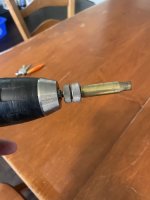You are using an out of date browser. It may not display this or other websites correctly.
You should upgrade or use an alternative browser.
You should upgrade or use an alternative browser.
Anybody in GTA or North of 407 - doing brass annealing?
- Thread starter bigHUN
- Start date
BattleRife
CGN Ultra frequent flyer
- Location
- of No Fixed Address
Some big assumptions being made here. Depending on exactly what testing he intends to do, the world's crudest, sloppiest, and most inconsistent technique may not be adequate.
And, what's the water for, exactly?
And, what's the water for, exactly?
Stand the cases in a pan of water. Heat neck and shoulder until colours appear. Knock over.Some big assumptions being made here. Depending on exactly what testing he intends to do, the world's crudest, sloppiest, and most inconsistent technique may not be adequate.
And, what's the water for, exactly?
Big assumptions when someone asks about annealing? Seems pretty straightforward.Some big assumptions being made here. Depending on exactly what testing he intends to do, the world's crudest, sloppiest, and most inconsistent technique may not be adequate.
And, what's the water for, exactly?
I was only reading about from "big" names in the sport, that they annealing brass after each shot.
Otherwise I am educated with the process what annealing does to materials. I am even annealing my 3d printed parts if kinetics critical for my assembly.
To make a rotating table for torch is easy, only my garage is not suitable for open fire/flame....have chemicals that I don't want to move in and out all the time.
Btw, heating up the brass until change in colour and knock it over in a pan of water is opposite of annealing
Otherwise I am educated with the process what annealing does to materials. I am even annealing my 3d printed parts if kinetics critical for my assembly.
To make a rotating table for torch is easy, only my garage is not suitable for open fire/flame....have chemicals that I don't want to move in and out all the time.
Btw, heating up the brass until change in colour and knock it over in a pan of water is opposite of annealing
Last edited:
Btw it’s not the opposite of annealing. Brass will work harden and age harden that’s it.I was only reading about from "big" names in the sport, that they annealing brass after each shot.
Otherwise I am educated with the process what annealing does to materials. I am even annealing my 3d printed parts if kinetics critical for my assembly.
To make a rotating table for torch is easy, only my garage is not suitable for open fire/flame....have chemicals that I don't want to move in and out all the time.
Btw, heating up the brass until change in colour and knock it over in a pan of water is opposite of annealing
Win 308 about 200 - after I shot these next timeWhich caliber and how many brass?
That's not true. Brass doesn't get hard when quenched. Air cool it, cool it over 24 hours in a over or water quench it it's all the same in the end.Btw, heating up the brass until change in colour and knock it over in a pan of water is opposite of annealing
I never bothered with water; the shells cool within a few minutes. I just loosened the shell holder and let them drop into my sophisticated shell case (metal coffee can).
Keep your torch flame as low as possible to to give yourself time.
Point the blue tip at the base of the neck and spin.
Watch for the surface of the brass to change colour or 'silvering' as some call it. You can tell after a while when it's just right.
Practice on some discarded range brass first.

Keep your torch flame as low as possible to to give yourself time.
Point the blue tip at the base of the neck and spin.
Watch for the surface of the brass to change colour or 'silvering' as some call it. You can tell after a while when it's just right.
Practice on some discarded range brass first.

That shell holder.... who's making these........I just loosened the shell holder and let them drop into my sophisticated shell case (metal coffee can)....
View attachment 816461
BattleRife
CGN Ultra frequent flyer
- Location
- of No Fixed Address
That's the shell holder and drill stud of the Lee case trimmer set.That shell holder.... who's making these






































































